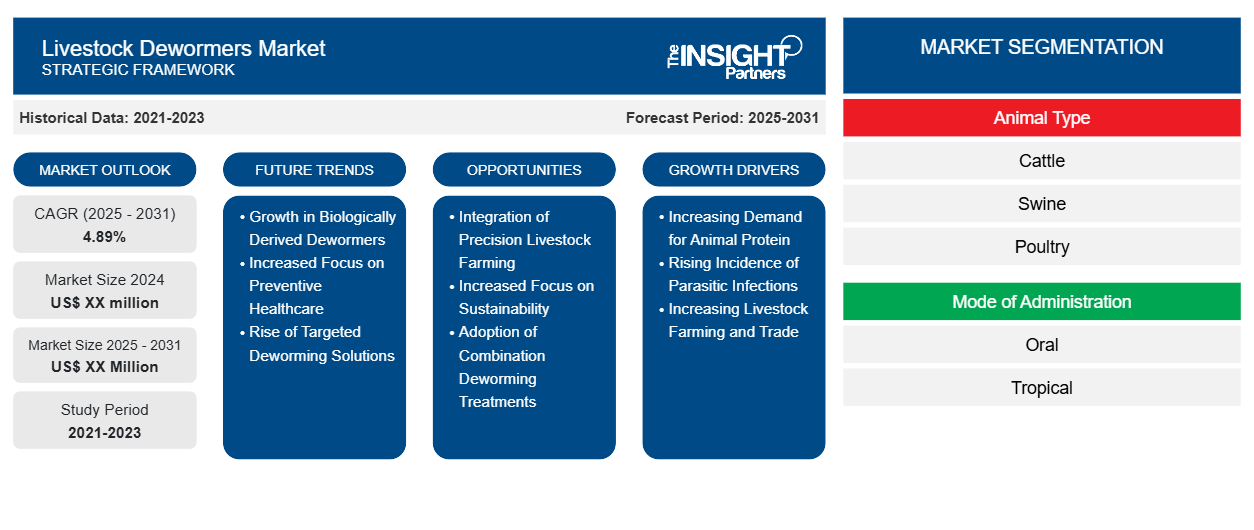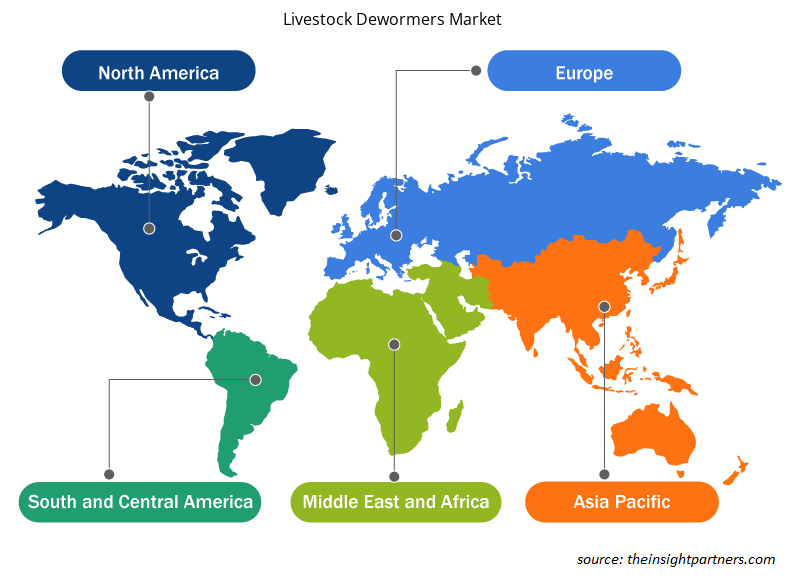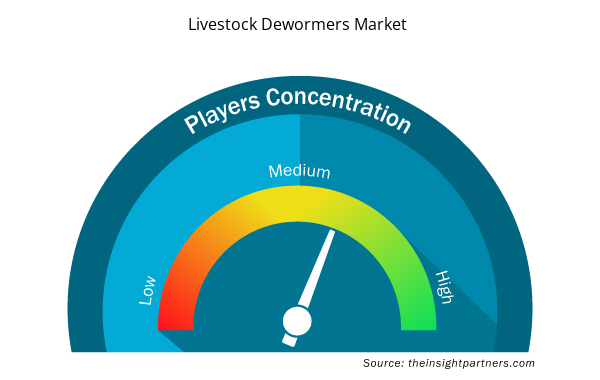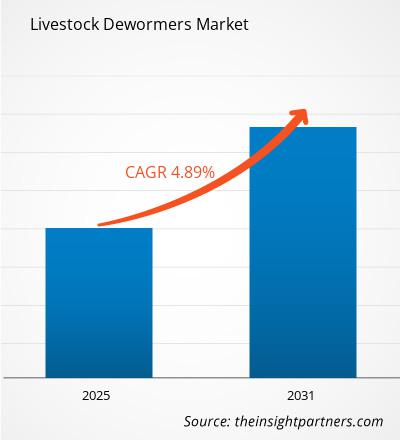The Livestock Dewormers Market is expected to register a CAGR of 4.89% from 2025 to 2031, with a market size expanding from US$ XX million in 2024 to US$ XX Million by 2031.
The report is segmented by Animal Type (Cattle, Swine, Poultry, Other Animals); and Mode of Administration (Oral, Tropical, Others). The global analysis is broken down at the regional level and for major countries. The market evaluation is presented in US$ for the above segmental analysis.
Purpose of the Report
The report Livestock Dewormers Market by The Insight Partners aims to describe the present landscape and future growth, top driving factors, challenges, and opportunities. This will provide insights to various business stakeholders, such as:
- Technology Providers/Manufacturers: To understand the evolving market dynamics and know the potential growth opportunities, enabling them to make informed strategic decisions.
- Investors: To conduct a comprehensive trend analysis regarding the market growth rate, market financial projections, and opportunities that exist across the value chain.
- Regulatory bodies: To regulate policies and police activities in the market with the aim of minimizing abuse, preserving investor trust and confidence, and upholding the integrity and stability of the market.
Livestock Dewormers Market Segmentation
Animal Type
- Cattle
- Swine
- Poultry
- Other Animals
Mode of Administration
- Oral
- Tropical
Customize This Report To Suit Your Requirement
You will get customization on any report - free of charge - including parts of this report, or country-level analysis, Excel Data pack, as well as avail great offers and discounts for start-ups & universities
Livestock Dewormers Market: Strategic Insights

- Get Top Key Market Trends of this report.This FREE sample will include data analysis, ranging from market trends to estimates and forecasts.
Livestock Dewormers Market Growth Drivers
- Increasing Demand for Animal Protein: he rising global demand for animal protein is one of the key drivers propelling growth in the Livestock Dewormers Market. More people in developing nations like China, India, and Brazil now eat more meat, dairy products, and eggs because of population growth and changing food habits. Animal production systems need to boost animal health and performance to meet rising protein demands and deworming supports these efforts. Dewormers keep livestock healthy by stopping parasitic infections which slow animal growth and reduce their ability to use feed efficiently. When animals produce more output from their feed they need more deworming solutions to stay healthy. Global trade in meat and livestock products requires more animal health products because animals moved from one region to another become vulnerable to multiple parasites. Farmers need to use deworming treatments to keep their livestock healthy because they want to increase animal output to supply more animal protein. Developing regions that switch to modern farming methods create new opportunities for dewormer consumption. The market will keep growing because farmers now put more effort into sustainable livestock farming and produce more animals.
- Rising Incidence of Parasitic Infections: The Livestock Dewormers Market grows because farmers and ranchers worldwide now prioritize deworming treatments due to increasing livestock parasite problems. Gastrointestinal worms and lungworms along with flukes and external parasites like lice and mites put serious harm to livestock health. Parasitic infections decrease how much feed animals eat and slow their growth before becoming fatal. The health and production of livestock depend on proper deworming methods. Parasites developing resistance to deworming drugs requires better treatment solutions to address the problem. The need to battle resistant parasites increases market demand for dewormers that work better than traditional solutions. More farmers recognize the permanent health and productivity problems from parasites so they put money into good deworming systems. Government agencies like FDA and WHO work together with health organizations to help farmers control parasitic diseases in their livestock. Veterinarian medicine developments and improved awareness about parasites help farmers begin proactive worm treatment which increases market growth. Farmers now invest more in disease prevention because animal care costs keep rising so they need better preventive deworming medicine.
- Increasing Livestock Farming and Trade: The Livestock Dewormers Market grows because both the farming industry is expanding and global trade of livestock and meat products increases. Economically developing nations boost their food production by raising more livestock. Our world needs more livestock farming to feed people and deworming helps animals stay healthy to deliver good output. People who raise livestock worldwide need dewormers to stop parasites from hurting their animals and must spend more on veterinary services and produce less because of these problems. International trade in livestock products and their products especially meat milk and eggs creates more demand for effective worm treatments. When animals travel between countries they encounter different parasite types that do not exist in their home areas. Farmers must use preventive deworming to protect their animals from disease risks while they travel and live on new farms. The Asia-Pacific North America and Latin America markets for animal exports keep expanding which increases the need for dewormers. Farmers use advanced deworming tools because they need better health and higher production results to stay successful in international markets. Deworming product sales will keep rising because farmers worldwide now prioritize livestock health while expanding their business operations.
Livestock Dewormers Market Future Trends
- Growth in Biologically Derived Dewormers: The Livestock Dewormers Market has been developing steadily biologically derived dewormers in recent years. Plant-based, microbial, and natural alternatives are a sustainable, sustainable way to fight parasitic infection in animals. The more the world becomes conscious of environmental issues, the more demand for biodegradable, non-toxic materials will emerge. Biologically based dewormers are often thought to be safer for animals and the environment than chemical dewormers that may leave traces in the soil and waterways. Especially the adoption of environmentally sound farming methods is pushing for natural dewormers that are both efficient and ethical. They’re also less likely to lead to anthelmintic resistance, a growing problem with traditional dewormers. What’s more, as consumers demand humanely raised animal foods, farmers seek ways to reduce their environmental impact while ensuring animal health and yields. The trend toward biological treatments is also associated with the trend toward sustainable agriculture and natural animal husbandry, which is anticipated to continue propelling the market. Then there is the development of microbial dewormers and plants, and new products are now available that work and are more environmentally benign. As demand for sustainability and natural products increases, the market for biologically based dewormers will grow in its trend toward new avenues of innovation.
- Increased Focus on Preventive Healthcare: One of the major trends impacting the Livestock Dewormers Market is growing preventive medicine. Because vet expenses are on the rise, producers are reverting to more proactive solutions to keep livestock safe from parasitic infections and increase herd welfare. Preventive deworming programs are becoming increasingly popular in livestock management to prevent parasitic infections before they affect the production of livestock. Several veterinarians are now prescribing deworming regularly as part of a wider health-care approach, rather than treating infections once they have set in. Not only does this preventive action lessen the risk of serious infections, but also helps keep growth rates, feed conversion rates, and overall animal productivity high. There are integrated pest management (IPM) approaches that use deworming along with other techniques like better sanitation, pasture rotation, and vaccination. Deworming products are increasingly part of an approach to holistic livestock management as opposed to a reactive healthcare strategy. The pattern is heightened both in mature and developing countries, where farmers are now much more aware of the long-term health advantages of frequent deworming programs. Health-promoting care and a focus on disease prevention are prompting a steady demand for dewormers that can provide effective, lifelong protection against parasitic infection.
- Rise of Targeted Deworming Solutions: The Latest Trend In the Livestock Dewormers Market is the rise of targeted deworming solutions. Traditional dewormers work, but generally, they aren’t specific enough and the active ingredient tends to become resistant and overused. However, more targeted treatments aimed at specific parasites or pathogens are emerging. Such therapies are used to fight specific parasitic infections more precisely, which lowers the potential for resistance and keeps deworming products off the table if they are required. This demand is driving manufacturers to make more specific dewormers — better suited to particular animals or forms of parasite infection. A cow or sheep might need deworming treatments for different parasites, for example. Second, combination therapies in which multiple deworming medications are used in tandem for optimal effects are on the rise. These advances in targeted deworming make controlling parasitic infections more sustainable and more efficient – and less susceptible to resistance. What’s more, these more targeted treatments also enable farmers to treat livestock more efficiently by targeting only the most harmful parasites. Precision veterinary care and data-based agricultural solutions are fueling demand for targeted dewormers, and that is only set to continue as the industry shifts to better and more effective approaches to livestock health.
Livestock Dewormers Market Opportunities
- Integration of Precision Livestock Farming: The Livestock Dewormers Market gains new opportunities as precision livestock farming becomes more common. Through precision farming systems farmers use technology to measure animal well-being and conduct. Farmers use technology data to decide better times for deworming their animals. The new approach helps farmers apply worm treatments more precisely which saves money while giving better treatment results. Smart animal monitoring devices with sensors on livestock detect health problems early so farmers can start treatment when infections first appear rather than when they become widespread. Starting treatment sooner helps stop health problems from developing while boosting farm output. By combining disease management tools with data analysis farmers can see how well their treatments work and make better treatment decisions. More farmers will want deworming solutions that work with advanced agricultural technology as precision agriculture becomes more popular. Manufacturers who create farming equipment that matches precision farming requirements will benefit from this market growth.
- Increased Focus on Sustainability: Sustainability stands as a primary focus in the Livestock Dewormers Market. Customers now prefer buying products that come from sustainable farming methods and protect the planet which drives demand for eco-friendly farming methods. Farmers now seek deworming solutions that protect the environment and do not create new drug-resistant strains of microbes. People are choosing biologically derived and natural deworming solutions because they think these methods are safer for livestock and the environment. Demand for eco-friendly deworming products will grow because consumers and government agencies now expect sustainable practices from farmers. Manufacturers who develop deworming solutions that match consumer preferences for eco-friendly and natural products can stand out from competitors and get into this new market segment. The market for biodegradable and non-toxic dewormers will increase because sustainable farming methods support their growth.
- Adoption of Combination Deworming Treatments: The Livestock Dewormers Market has new growth opportunities through combination deworming treatments. People choose combination dewormers because these products work against many types of parasites at once. Combination deworming treatments work best in areas where livestock encounter many different parasites including worms in their intestines and lungs plus external parasites. When farmers combine different treatments they can treat their livestock more effectively while using fewer drugs. Combination worm medications help prevent parasite resistance when farmers alternate between multiple drug types because parasites are less likely to build resistance to multiple drugs at once. People are learning about anthelmintic resistance which will make combination treatments a regular way to fight livestock parasitic diseases. Manufacturers who create reliable combination dewormers will find success in the expanding market sector.
Livestock Dewormers Market Regional Insights
The regional trends and factors influencing the Livestock Dewormers Market throughout the forecast period have been thoroughly explained by the analysts at Insight Partners. This section also discusses Livestock Dewormers Market segments and geography across North America, Europe, Asia Pacific, Middle East and Africa, and South and Central America.

- Get the Regional Specific Data for Livestock Dewormers Market
Livestock Dewormers Market Report Scope
| Report Attribute | Details |
|---|---|
| Market size in 2024 | US$ XX million |
| Market Size by 2031 | US$ XX Million |
| Global CAGR (2025 - 2031) | 4.89% |
| Historical Data | 2021-2023 |
| Forecast period | 2025-2031 |
| Segments Covered |
By Animal Type
|
| Regions and Countries Covered | North America
|
| Market leaders and key company profiles |
Livestock Dewormers Market Players Density: Understanding Its Impact on Business Dynamics
The Livestock Dewormers Market market is growing rapidly, driven by increasing end-user demand due to factors such as evolving consumer preferences, technological advancements, and greater awareness of the product's benefits. As demand rises, businesses are expanding their offerings, innovating to meet consumer needs, and capitalizing on emerging trends, which further fuels market growth.
Market players density refers to the distribution of firms or companies operating within a particular market or industry. It indicates how many competitors (market players) are present in a given market space relative to its size or total market value.
Major Companies operating in the Livestock Dewormers Market are:
- Zoetis
- Virbac
- Merck Animal Health
- Elanco
- Boehringer Ingelheim
- Bayer
Disclaimer: The companies listed above are not ranked in any particular order.

- Get the Livestock Dewormers Market top key players overview
Key Selling Points
- Comprehensive Coverage: The report comprehensively covers the analysis of products, services, types, and end users of the Livestock Dewormers Market, providing a holistic landscape.
- Expert Analysis: The report is compiled based on the in-depth understanding of industry experts and analysts.
- Up-to-date Information: The report assures business relevance due to its coverage of recent information and data trends.
- Customization Options: This report can be customized to cater to specific client requirements and suit the business strategies aptly.
The research report on the Livestock Dewormers Market can, therefore, help spearhead the trail of decoding and understanding the industry scenario and growth prospects. Although there can be a few valid concerns, the overall benefits of this report tend to outweigh the disadvantages.
- Historical Analysis (2 Years), Base Year, Forecast (7 Years) with CAGR
- PEST and SWOT Analysis
- Market Size Value / Volume - Global, Regional, Country
- Industry and Competitive Landscape
- Excel Dataset



Report Coverage
Revenue forecast, Company Analysis, Industry landscape, Growth factors, and Trends

Segment Covered
This text is related
to segments covered.

Regional Scope
North America, Europe, Asia Pacific, Middle East & Africa, South & Central America

Country Scope
This text is related
to country scope.
Frequently Asked Questions
The Livestock Dewormers Market is estimated to witness a CAGR of 4.89% from 2025 to 2031.
The major factors driving the Livestock Dewormers Market are Increasing Demand for Animal Protein, Rising Incidence of Parasitic Infections, and Increasing Livestock Farming and Trade.
Future trends in the Livestock Dewormers Market are Growth in Biologically Derived Dewormers, Increased Focus on Preventive Healthcare, and Rise of Targeted Deworming Solutions.
Some of the players operating in the market are Zoetis, Virbac, Merck Animal Health, Elanco, Boehringer Ingelheim, Bayer, International Animal Health Products, Durvet Animal Health Products, Manna Pro Products LLC, First Priority, Inc.
The report can be delivered in PDF/PPT format; we can also share an excel datasheet based on the request.
Some customization options available based on the request are an additional 3–5 company profiles and a country-specific analysis of 3–5 countries of your choice. Customizations are to be requested/discussed before making final order confirmation# as our team would review the same and check the feasibility.
Trends and growth analysis reports related to Life Sciences : READ MORE..
1. Zoetis
2. Virbac
3. Merck Animal Health
4. Elanco
5. Boehringer Ingelheim
6. Bayer
7. International Animal Health Products
8. Durvet Animal Health Products
9. Manna Pro Products LLC
10. First Priority, Inc.

 Get Free Sample For
Get Free Sample For